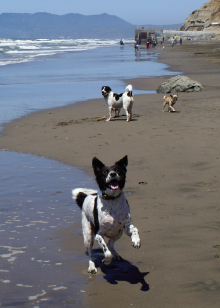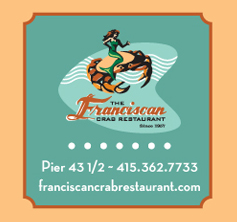
photo: Valerita/Flickr.com
As we headed along the shoreline toward the Warming Hut, I dutifully hooked my dog up to her leash as we entered the wildlife protection area of West Beach – about where the sand widens before the old pier. As the posted signs explain, dogs are required to be on leash between July 1 and May 15, the time of year when Snowy Plovers sometimes visit our sandy shores. My friend and her wards, however, kept walking along the water without a change in pace.
Was she ignorant of the rules that were clearly posted? Did she have no respect for the protected wildlife?
No to both questions. My friend was walking with her two children.
NO HARD FACTS THAT DOGS ARE DETRIMENTAL
I use this example to question the theory that a single, historical user group can be designated as detrimental to the future of a healthy park, as the Golden Gate National Recreation Area (GGNRA) has done. In their Draft Dog Management Plan/Environmental Impact Statement, which is open for public comment through May 30, they hypothesize that dogs create a singular burden on the future of park resources.
I say hypothesize because there aren’t a lot of hard facts in the 2,400-page document to prove that position. A 39-year history of use under existing policies also proves otherwise. Running, digging, chasing birds, making noise – the joyous actions of the children I was walking with – are used as examples of the disastrous affects that dogs alone, and especially off-leash dogs, supposedly have on the park and its wildlife.
DOGS OFF-LEASH SINCE THE 1800s
According to SF Dog (www.sfdog.org), there are written records going back to the 1800s of people walking their dogs off-leash in the lands now held by the GGNRA. This specific use was included in Congressional hearings that resulted in the creation of this national recreation area in 1972. After an attempt was made by the National Park Service to curtail off-leash walking in the mid-1970s, what is known as the 1979 Pet Policy was established by the U.S. Department of the Interior to allow recreation with both off-leash and on-leash dogs in specific areas of the park.
Since that policy was enacted, users have enjoyed walking with their dogs off-leash in a miniscule one percent of the GGNRA’s 75,000-plus acres. While this area includes trails and parklands in the Marin Headlands, Lands End and other areas, some of the most popular areas used are Fort Funston, Ocean Beach, Baker Beach, and Crissy Field in San Francisco, and Rodeo Beach and Muir Beach in Marin. That is about 8 miles of beach, shared between San Francisco and Marin Counties, of the more than 60 miles of shoreline within the GGNRA. More to the point, that leaves 52 miles of waterfront without dogs.
THREATENED SPECIES NOT ENDANGERED IN DOG-walking AREAS
According to the GGNRA, 886 species of plants, 53 species of mammals, 250 species of birds, 20 species of reptiles, and 11 species of amphibians have been found within the park. A total of 36 threatened and endangered species exist within the area’s legislative boundaries – most are not endangered by conditions here, but rather by their population numbers worldwide. This amazing diversity exists within a recreation area that has hosted hikers, bikers, dog walkers, horse riders, hang gliders, surfers, windsailers, and automobiles for decades.
The western snowy plover and the North American bank swallow are two of the threatened species used as a call to arms by environmentalists pushing to remove dogs from most of the beaches in the GGNRA (including Crissy Field, Rodeo Beach, and most of Fort Funston and Ocean Beach). However, as the GGNRA admits, the sites currently open to recreation with dogs (as defined by the Pet Policy) include no critical habitats or nesting areas for either bird. Snowy plovers visit the sandy beaches of Crissy Field and Ocean Beach for feeding and resting, and unbiased studies have shown that nearby recreational use appears to have little impact on the plover numbers. Bank swallows reside in the cliffs above Fort Funston, far above the people with (or without) dogs enjoying the beach below.
The debate over dog management in the GGNRA has been wrongly portrayed as an issue of dogs versus the environment. Dog advocates are also vocal environmentalists, and their groups regularly hold cleanup days at each of the beaches in question for the benefit of all users. No responsible dog walker allows a pet to harass wildlife or disturb a threatened species. In fact, it is already against the Pet Policy and federal law to do so, and someone can (and should be) ticketed for such an offense.
GGNRA SEEKS TO ‘MANAGE’ BY ELiMINATING DOGS
When it was established, the Pet Policy was defined as being a flexible system: “The success of such a system is dependent upon the willingness of visitors and local residents to cooperate with GGNRA personnel, and the willingness of GGNRA personnel to manage dogs, people and wildlife situations; to enforce regulations; and to cite violators.”
What has failed in this plan is the willingness of GGNRA personnel to manage the situation. Park staff made unilateral attempts to end the Pet Policy in 1991, 2000 and 2001, resulting in the negotiated rulemaking process that culminated in the proposed Draft Dog Management Plan we have today. Presented to the public in February, it attempts to manage dogs, people and wildlife situations by simply eliminating dogs from the equation.
NO REASON TO CHANGE PET POLICY
In discussing documented wildlife within the park, the GGNRA states, “Whether using park resources broadly or specifically, year round or for less than 24 hours, all of these animals depend on the Recreation Area as a refuge from expanding development outside of park boundaries.”
That is exactly the same reason the Golden Gate National Recreation Area was created in 1972 for the residents of the Bay Area. We have had few problems sharing this respite from development for the last 39 years, and no scientific facts uphold that recreation with dogs poses any more damage or danger than recreation with your children or your bicycle. With both recreational users and wildlife populations thriving, there is no pressing reason to change the existing Pet Policy.
Let the GGNRA know before May 30 that none of the preferred options in the proposed plan are acceptable or necessary. To submit your comments online, visit www.parkplanning.nps.gov/dogplan and click on the “Open for Comment” link in the list to your left. You can also mail comments to:
Frank Dean, General Superintendent
Golden Gate National Recreation Area
Building 201, Fort Mason
San Francisco, CA 94123-0022
Cindy Beckman is the editor of the Marina Times. To read additional articles on the GGNRA’s Draft Dog Management Plan, visit www.marinatimes.com/pets.html








